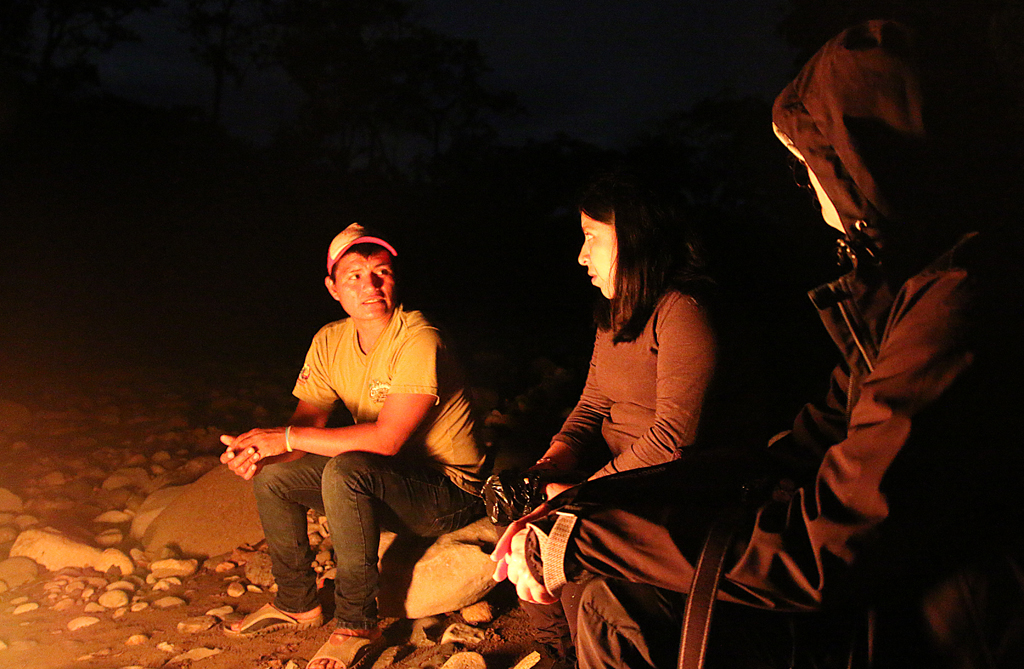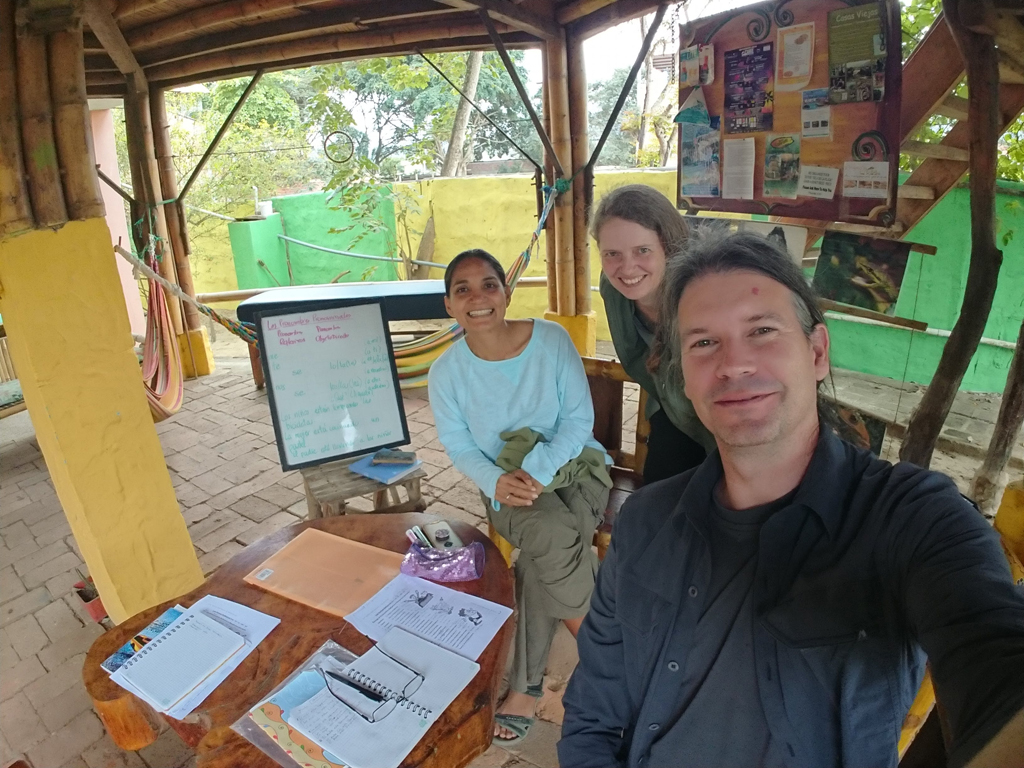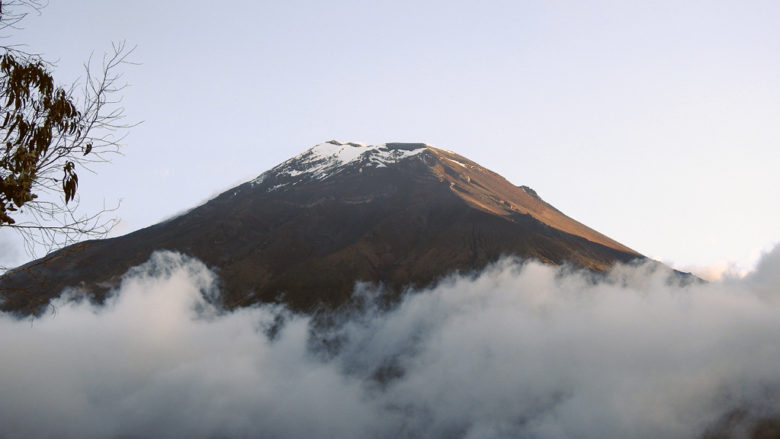This post is also available in: Dansk
It has been five weeks since we left Denmark and started on our Latin American Time-out. Those of you who have been following our blog, know that the Latin American part didn’t actually begin until four weeks ago – as we started with a weeks’ vacation in Florida (USA). You can read about that in the entry Family meet-up, a Space Shuttle and some Black Skimmers and Everglades drive through and close encounter by the gator kind.
Travel and learn Spanish
We are in Ecuador, where the last four weeks have not been spent idle! It may be that we are taking a time-out but that does not mean we are lounging around. On the contrary – so far we have spent the time learning Spanish, or to be more precise, attempting to learn Spanish.
For four weeks we have received Spanish lessons in La Lengua language school, where we followed the study program Travel and study 4 Weeks Spanish Program and we have now completed the course. Time flies when you are conjugating verbs and it feels strange not to have homework to prepare for tomorrow!
In four weeks we have experienced a lot and learned a lot more Spanish than we knew before traveling to South America, but there is still a long way to go.
The first week in Quito
We spent the first week in Quito, a huge city in the Andes with three million people. There is a sea of people and a lot of traffic, chaos, and noise.
We stayed with the nicest family – Gabriela Ortiz Cazar, Eulalia Cazar Rivera and Jose Ricardo as well as their dog “Negracita” – and they deserve a huge thanks for making us feel so welcome. Their apartment was right next – as in right next – to the language school. It took three minutes to get to school, so it was very convenient and we didn’t have to take a bus and be packed like sardines.

“What are you doing – it says don’t touch !” Gabriela and Eulalia at the museum in La Ronda. Quito, Ecuador.
In the mornings the Spanish lessons took place at the school’s premises on the 8th floor in the Mariscal district. Naturally, we started out learning the basics, like how to say which country you are from and what nationality you are. But we quickly build on that with a lot of new words and conjugation of verbs. The first two weeks everything took place in the present tense (you can read a little about that in Late arrival, our host family and living in present) as we did not learn past and future tense until later.
As part of our “field lessons” our teacher Ligia took us to the old and beautiful part of Quito, Quito Colonial or Quito Historico. On Wednesday we drove to the town Saquisilí two hours South of Quito. Here we got to experience the many markets of the city where you could buy all sorts of more or less exotic fruit and vegetables. And you could, of course, also buy chickens, ducks, sheep and goats – and guinea pigs, which are not kept as pets here.
And yes – we did have guinea pig for lunch that day. It was OK, and tasted a bit like… chicken, and then again, not so much. It probably tasted mostly like a roasted guinea pig.
The vacation town Baños (de Santa Agua)
According to the program for week two, the transport to Baños was supposed to take place by bus. But as it was Ligia we had as teacher and her husband Vinicio was also going, we drove in their car. There was not much room, but we managed to cram the luggage of four people into the small car, and after half an hour we drove south on the famous Panamerican Highway.
It was a really nice trip to Baños. All conversations were of course in Spanish, which meant that there were probably things we did not quite catch. Along the way, we stopped for ice-cream, which Bente found to be a bit of a challenge due to the time pressure (a very large, cold and very hard ice cream). On the other hand, she helped the owner of the cafe attract customers.
We knew that we would have three hours of lessons every day at the hotel where we were staying. But what we did not know was that it was also a week of hard exercise. We went mountain hiking and on bike rides! But physical exercise is also supposed to help you learn.
Getting to and from our hotel was quite an exercise in itself as we lived on a very steep hill. So even though we were only 1800 meters above sea level, as opposed to the 2800 meters in Quito, we could really feel it when we were going home.
One afternoon we went for a hike on a hillside to enjoy the view and nature – and to see the volcano Tungurahua. We have to add that Ligia and Vinicio are both in quite a good shape (they both run and ride bikes) and I think they thought we were in just as good a shape as them – according to Ligia we were very close to where we could see the volcano just a little bit more climbing!
But we did get to see the volcano and it was impressive and looks just like a volcano should. We were lucky enough that the weather cleared up so we could see the snow-covered peak.

The beautiful view of the volcan Tungurahua. Baños, Ecuador.
The day ended with us, and a lot of young people from Argentina, being driven up to a place with a very famous house in a tree. We got a couple of new bird species on the list before going back down to a candy store where we were shown how the candy was made.

Vinicio, Ligia, Bente og Uffe at Casa de Arból. Baños, Ecuador.
Pailón de Diablo (Devil’s Cauldron)
In the middle of the week, we went on a 15 km bike ride, it was downhill most of the way so it was really not that hard. We visited Pailón de Diabló which is a magnificent waterfall about 80 meters high. You can go in behind the water curtain – but you will get rather wet if you do so.
It is a very beautiful place with rainforest which also meant that we got some more bird species on our list – and we also saw some orchids.
The transport back to Baños was on the bed of a truck and we, therefore, avoid a very long ascent.

Ligia og Uffe in front of the waterfall Pailón de Diabló, Ecuador.
The Zoo
We also visited the local zoo. I don’t want to start a debate about birds and animals in cages, but let’s just say that we feel a bit ambivalent about zoos. But we thought if it as part of the Spanish lessons perhaps we could learn some useful phrases in Spanish about animals and nature.
It was a very friendly guide who showed us around the zoo. She told us what species we saw and several times she mentioned that a particular species was endangered due to its habitats being destroyed. It was sad to hear (though we already knew). It was particularly sad to see the three large Andean condors in an enclosure barely large enough for them to fly a few meters (while touching the net covering).
In all fairness, we should say that it was a relatively large zoo and most of the birds and animals were not just put in small cages. There were some larger cages and enclosures with trees and plants.
But I really hope that at least some of the visitors to the zoo do not just think that it is fun to get close to some beautiful animals, but actually take note of it and will try to do something to preserve the wild nature and the habitats of birds and animals.
Suchipakari i Amazonas
It took about an hour to drive from the school in Quito to the bus station in Quitumbe. From there it was a five-hour bus ride to the town Tena in the Amazon.
Along the way, the bus almost left Bente and Mayra – our teacher during the third week – behind after a bathroom break in one of the towns it passed through. But luckily they both caught the bus after all. In Tena, we drove half an hour by taxi to the Suchipakari lodge which located at a tributary to the Napo River.
After settling in, in a nice little cabaña, we had almuerzo (lunch, always consisting of three dishes, one of them soup – as in always) before our afternoon classes.

Learning Spanish and having almuerzo with Mayra. Suchipakari Amazon Jungle Lodge, Amazonas, Ecuador.
Like the previous weeks, there was a mix of lessons and other activities. Our guide at Suchipakari was Manuel. Together with him and Mayra we tried to make chocolate from scratch. First, we roasted the dried cocoa beans over an open fire. Then we removed the shells and ground the beans. We mixed it with milk and soon we had the finest cacao which we ate with strawberries and pineapples.
Manuel took us for a walk through one of the lodges’ paths through the woods and told us about some of the medicinal properties of the plants. We also tested termites as a mosquito repellent and finally, he showed how the women could adorn themselves with nature’s own remedies.

Beautiful ladies in the jungle. Amazonas, Suchipakari Amazon Jungle Lodge, Ecuador.
On the Tuesday, Manuel took us down to the river bank after sundown. We thought we were going on a night walk to see some nocturnal animals. Now we are not so good at Spanish yet, so it turned out we were going to make a fire, and tell stories while we drank hot guayusa liqueur in the moonlight. A really nice evening that lasted a couple of hours until the bonfire had burned down and we went back to the lodge.

Enjoying the Amazon night with a bonfire at the river bank. Suchipakari Amazon Jungle Lodge, Amazonas, Ecuador.
Sacha Sisa Amazon Lodge
Due to overbooking we had to change lodge. After breakfast we walked down to Rio Napo together with Manuel, where we got in a motorized long canoe. Before sailing to the new lodge we first had to visit one of the small villages where some of the indigenous tribes of the Amazon lives.
One of the young woman from the village showed us how to extract, from the leaves of a tree, some fibres that are used for making nets and jewellery. She also showed how the production of ceramics takes place. It was very interesting to see.

Manufacture of ceramics in traditional manner. Rio Napo, Amazonas, Ecuador.
We sailed down Rio Napo and ate the “lunch box” we had brought on the river bank, before sailing on to the lodge Sacha Sisa Amazon Lodge.
It was a somewhat more primitive place than the previous lodge, and at the same time, we were the only guests. However, it had the most beautiful view over the Amazon and Rio Napo. Here you really felt that you were in the famous “jungle”.
There were three dogs and a little “Pippi Longstocking” monkey. The monkey was at times very annoying as it wanted to bite our toes. It was not easy to concentrate on the lessons when we also had to keep an eye out for the monkey.
According to the plan, we were supposed to go on a long hike through the woods on Thursday to see a waterfall. But we changed the plans as it turned out that the lodge manager was also interested in birds. He had previously worked with botany some 20-25 years ago, where he worked together with some Danes from the organization Nepenthes (the current Verdens Skove). He offered to take us on an early morning bird trip the next day on the other side of the river, which we, of course, agreed to.
The next morning at 5:30 we were ready for a birding trip. We sailed across the river and went ashore. Dawn was breaking as we saw the first toucans.

Morning birding – waiting for the transport to take us across the river. Rio Napo, Amazonas, Ecuador.
We will skip the details this time, but it was a really nice trip, where we saw some new bird species (including Black-fronted Nunbird and White-eared Jacamar) and two kinds of monkeys. What we thought was a real rainforest, turned out to be more cultivated with various crops. However, we also came into some dense thicket – and got some good observations of one of the strangest and most special birds in Amazon – Hoatzin.

Dusky-headed Parakeets. Rio Napo, Amazonas, Ecuador.

Hoatzin – a relic from the past. Rio Napo, Amazonas, Ecuador.
Puerto Lopez on the Pacific coast
The fourth and last week of language school started with a nine hours trip on the night bus from Quito to Puerto Lopez. It was Paola who had the pleasure of being our teacher and she also picked us up at the bus station early Monday morning. This time it was a parrot (Red-masked Parakeet) that made studying difficult – by eating our homework. Try using that excuse with your teacher!

Spanish lesson with Paola in Puerto Lopez. Puerto Lopez, Ecuador.
Together with Paola, we visited Agua Blanca, northeast of Puerto Lopez. In Agua Blanca, where there live about 300 people, some archaeological finds have been made. We saw the little museum and a guide told about the exhibits. The guide went with us on a trip through the woods – to watch birds – and swim in a “sulfur lake”! The forest is of the type of tropical drought forest, and at this time of the year it is very dry and mostly looks wilted and dried out. The trees look dead – but they are not and everything will turn green in a few months.
The next day we visited Playa de Los Frailes a little north of Puerto Lopez. We went for a walk along three small beaches. A very nice area. On our way back to the car we met two people who got a lift with us into town. Fernando from Colombia knew Paola through some English lessons and Constanza (Coni) from Chile was a friend of Fernando. They were very sweet and we met up with them in the evening for drinks and talking about life’s big questions!

Enjoying the night with new friends, Fernando (Colombia), Constanza (Chile), Bente and Uffe (Danmark). Puerto Lopez, Ecuador.
During Thursday’s trip, the car unfortunately got a flat tire as we were heading to the surfer town of Montañita. It took some time as the local car-tires-patching-man had to eat breakfast first. And yes, there are people who specialize in patching car tires, a vulanizador, so we assume it happens quite often that people get a flat. But in the end he got it fixed and we saw the surfer town. We found that it was somewhat off surf-season, but that was probably for the best, as it appeared to be a town mostly for young people looking to party.

Beach life in the surfertown. Montañita, Ecuador.
We kind of expected to spend the afternoons during this week at the seaside with a cool drink doing the homework. Everyone says that it is so great on the beach in the sun. But it turns out that it is cloudy and a little chilly here on coast. So far we have not seen the sun in Puerto Lopez – maybe we’ll see it next week as we move south to Ayambe – still on the coast…. but more about that later.

Sommerfugl. Amazonas, Ecuador.
All pictures and videos © Bente Steffensen and Uffe Damm Andersen unless otherwise stated.

